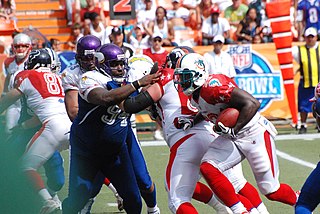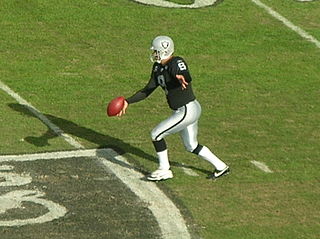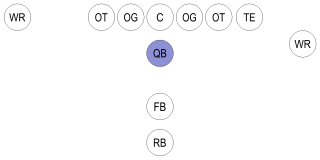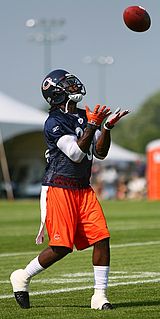 W
WIn American football, the specific role that a player takes on the field is referred to as their "position." Under the modern rules of American football, both teams are allowed 11 players on the field at one time and have "unlimited free substitutions," meaning that they may change any number of players during any "dead ball" situation. This has resulted in the development of three task-specific "platoons" of players within any single team: the offense, the defense, and the so-called 'special teams'. Within these three separate "platoons", various positions exist depending on the job that player is doing.
 W
WCenter (C) is a position in gridiron football. The center is the innermost lineman of the offensive line on a football team's offense. The center is also the player who passes the ball between his legs to the quarterback at the start of each play.
 W
WA cornerback (CB) is a member of the defensive backfield or secondary in gridiron football. Cornerbacks cover receivers most of the time, but also blitz and defend against such offensive running plays as sweeps and reverses. They create turnovers through hard tackles, interceptions, and deflecting forward passes.
 W
WIn gridiron football, defensive backs (DBs), also called the secondary, are the players on the defensive side of the ball who play furthest back from the line of scrimmage. They are distinguished from the other two sets of defensive players, the defensive linemen who play directly on the line of scrimmage, and the linebackers, who play in the middle of the defense, between the defensive line and the defensive backs.
 W
WDefensive end (DE) is a defensive position in the sport of gridiron football.
 W
WA defensive tackle (DT) is a position in American football that will typically line up on the line of scrimmage, opposite one of the offensive guards, however he may also line up opposite one of the tackles. Defensive tackles are typically the largest and strongest of the defensive players. Depending on a team's individual defensive scheme, a defensive tackle may be called upon to fill several different roles. These roles may include merely holding the point of attack by refusing to be moved, or penetrating a certain gap between offensive linemen to break up a play in the opponent's backfield. If a defensive tackle reads a pass play, his primary responsibility is to pursue the quarterback, or simply knock the pass down at the line if it is within arm's reach. Other responsibilities of the defensive tackle may be to pursue the screen pass or drop into coverage in a zone blitz scheme. In a traditional 4–3 defense, there is no nose tackle. Instead there is a left and right defensive tackle. Some teams, especially in the National Football League (NFL), do have a nose tackle in this scheme, but most of them do not.
 W
WIn American football, a dimeback is a cornerback or safety who serves as the sixth defensive back on defense. The third cornerback or safety on defense is known as a nickelback. The dimeback position is essentially relegated to backup cornerbacks and safeties who do not play starting cornerback or safety positions. Dimebacks are usually fast players because they must be able to keep up on passing plays with 3+ wide receivers.
 W
WEdge rusher is a term designating a position in gridiron football. Some analysts consider "edge rusher" to be its own position entirely.
 W
WAn end in American and Canadian football is a player who lines up at either end of the line of scrimmage, usually beside the tackles. Rules state that a legal offensive formation must always consist of seven players on the line of scrimmage and that the player on the end of the line constitutes an eligible receiver.
 W
WA fullback (FB) is a position in the offensive backfield in gridiron football, and is one of the two running back positions along with the halfback. Fullbacks are typically larger than halfbacks and in most offensive schemes the fullback's duties are split among power running, pass catching, and blocking for both the quarterback and the other running back.
 W
WIn gridiron football, a guard (G) is a player who lines up between the center and the tackles on the offensive line of a football team on the line of scrimmage used primarily for blocking. Right guards (RG) is the term for the guards on the right of the offensive line, while left guards (LG) are on the left side. Guards are to the right or left of the center.
 W
WIn American football, a gunner, also known as a shooter, flyer, headhunter, or kamikaze, is a player on kickoffs and punts who specializes in running down the sideline very quickly in an attempt to tackle the kick or punt returner. Gunners must have several techniques in order to break away or "shed" blockers, and have good agility in order to change their running direction quickly. Gunners on the punt team also must be able to block or catch.
 W
WA halfback (HB) is an offensive position in American football, whose duties involve lining up in the backfield and carrying the ball on most rushing plays, i.e. a running back. When the principal ball carrier lines up deep in the backfield, and especially when that player is placed behind another player, as in the I formation, that player is instead referred to as a tailback.
 W
WIn gridiron football, the holder is the player who receives the snap from the long snapper during field goal or extra point attempts made by the placekicker. The holder is set on one knee seven yards behind the line-of-scrimmage. Before the play begins he places the hand which is closest to the place kicker on the ground in a location designated by the kickers foot, with his forward hand ready to receive the snap. After receiving the snap, the holder will place the football on the turf, or block, ideally with the laces facing the uprights and the ball accurately placed where the back hand was initially, then balancing the ball with one or two fingers until the ball is kicked.
 W
WA linebacker is a playing position in gridiron football. Linebackers are members of the defensive team, and line up approximately three to five yards behind the line of scrimmage and behind the defensive linemen. The represent the "middle ground" of defenders, playing closer to the line of scrimmage than do the defensive backs, but further back than do the defensive linemen. As such, linebackers play a hybrid role and are often the most versatile players on the defensive side of the ball; they can be asked to play roles similar to either a defensive lineman or a defensive back. How a linebacker plays their position depends greatly on the defensive alignment, the philosophy of the coaching staff, and the particular play the offense may call.
 W
WIn gridiron football, a lineman is a player who specializes in play at the line of scrimmage. The linemen of the team currently in possession of the ball are the offensive line, while linemen on the opposing team are the defensive line. A number of NFL rules specifically address restrictions and requirements for the offensive line, whose job is to help protect the quarterback from getting sacked for a loss, or worse, fumbling. The defensive line is covered by the same rules that apply to all defensive players. Linemen are usually the largest players on the field in both height and weight, since their positions usually require less running and more strength than skill positions.
 W
WIn gridiron football, the long snapper is a special teams specialist whose duty is to snap the football over a longer distance, typically around 15 yards during punts, and 7–8 yards during field goals and extra point attempts.
 W
WIn American football, a nickelback is a cornerback or safety who serves as the additional defensive back in a nickel defense. A base defense consists of two cornerbacks and two safeties, making the nickelback the fifth defensive back on the field, thus tying the name of the position to the name of the North American 5-cent piece.
 W
WA defensive tackle (DT) is a position in American football that will typically line up on the line of scrimmage, opposite one of the offensive guards, however he may also line up opposite one of the tackles. Defensive tackles are typically the largest and strongest of the defensive players. Depending on a team's individual defensive scheme, a defensive tackle may be called upon to fill several different roles. These roles may include merely holding the point of attack by refusing to be moved, or penetrating a certain gap between offensive linemen to break up a play in the opponent's backfield. If a defensive tackle reads a pass play, his primary responsibility is to pursue the quarterback, or simply knock the pass down at the line if it is within arm's reach. Other responsibilities of the defensive tackle may be to pursue the screen pass or drop into coverage in a zone blitz scheme. In a traditional 4–3 defense, there is no nose tackle. Instead there is a left and right defensive tackle. Some teams, especially in the National Football League (NFL), do have a nose tackle in this scheme, but most of them do not.
 W
WA defensive tackle (DT) is a position in American football that will typically line up on the line of scrimmage, opposite one of the offensive guards, however he may also line up opposite one of the tackles. Defensive tackles are typically the largest and strongest of the defensive players. Depending on a team's individual defensive scheme, a defensive tackle may be called upon to fill several different roles. These roles may include merely holding the point of attack by refusing to be moved, or penetrating a certain gap between offensive linemen to break up a play in the opponent's backfield. If a defensive tackle reads a pass play, his primary responsibility is to pursue the quarterback, or simply knock the pass down at the line if it is within arm's reach. Other responsibilities of the defensive tackle may be to pursue the screen pass or drop into coverage in a zone blitz scheme. In a traditional 4–3 defense, there is no nose tackle. Instead there is a left and right defensive tackle. Some teams, especially in the National Football League (NFL), do have a nose tackle in this scheme, but most of them do not.
 W
WIn gridiron football, a guard (G) is a player who lines up between the center and the tackles on the offensive line of a football team on the line of scrimmage used primarily for blocking. Right guards (RG) is the term for the guards on the right of the offensive line, while left guards (LG) are on the left side. Guards are to the right or left of the center.
 W
WTackle is a playing position in gridiron football. Historically, in the one-platoon system prevalent in the late nineteenth and early twentieth centuries, a tackle played on both offense and defense. In the modern system of specialized units, offensive tackle and defensive tackle are separate positions, and the stand-alone term "tackle" refers to the offensive tackle position only. The offensive tackle is a position on the offensive line, left and right. Like other offensive linemen, their job is to block: to physically keep defenders away from the offensive player who has the football and enable him to advance the football and eventually score a touchdown. The term "tackle" is a vestige of an earlier era of football in which the same players played both offense and defense.
 W
WPlacekicker, or simply kicker, is the player in gridiron football who is responsible for the kicking duties of field goals and extra points. In many cases, the placekicker also serves as the team's kickoff specialist or punter as well.
 W
WA punter (P) in gridiron football is a special teams player who receives the snapped ball directly from the line of scrimmage and then punts (kicks) the football to the opposing team so as to limit any field position advantage. This generally happens on a fourth down in American football and a third down in Canadian football. Punters may also occasionally take part in fake punts in those same situations, when they throw or run the football instead of punting.
 W
WThe quarterback, colloquially known as the "signal caller", is a position in gridiron football. Quarterbacks are members of the offensive platoon and mostly line up directly behind the offensive line. In modern American football, the quarterback is usually considered the leader of the offense, and is often responsible for calling the play in the huddle. The quarterback also touches the ball on almost every offensive play, and is the offensive player that almost always throws forward passes. When the QB is tackled behind the line of scrimmage, it is called a sack.
 W
WA return specialist or kick returner is a player on the special teams unit of a gridiron football team who specializes in returning punts and kickoffs. There are few players who are exclusively return specialists; most also play another position such as wide receiver, defensive back, or running back. The special teams counterpart of a return specialist is a kicking specialist.
 W
WA running back (RB) is a member of the offensive backfield in gridiron football. The primary roles of a running back are to receive handoffs from the quarterback to rush the ball, to line up as a receiver to catch the ball, and block. There are usually one or two running backs on the field for a given play, depending on the offensive formation. A running back may be a halfback, a wingback or a fullback. A running back will sometimes be called a "feature back" if he is the team's starting running back.
 W
WSafety, historically known as a safetyman, is a position in gridiron football played by a member of the defense. The safeties are defensive backs who line up from ten to fifteen yards from the line of scrimmage who can play as linebackers or deep as normal safeties. There are two variations of the position in a typical American formation: the free safety (FS) and the strong safety (SS). Their duties depend on the defensive scheme. The defensive responsibilities of the safety and cornerback usually involve pass coverage towards the middle and sidelines of the field, respectively. While American (11-player) formations generally use two safeties, Canadian (12-player) formations generally have one safety and two defensive halfbacks, a position not used in the American game. As professional and college football have become more focused on the passing game, safeties have become more involved in covering the eligible pass receivers.
 W
WSlotback, sometimes referred to as an A-back or "slot receiver", is a position in gridiron football. The "slot" is the area between the last offensive lineman on either side of the center and the wide receiver on that side. A player who lines up between those two players and behind the line of scrimmage fills that "slot". The slotback position is a fixture of Canadian football and indoor football, but is also used in American football. The slotback requires a versatile player, who must combine the receiving skills of a wide receiver, the ball-carrying skills of a running back, and the blocking skills of a tight end.
 W
WIn American football, the specific role that a player takes on the field is referred to as their "position." Under the modern rules of American football, both teams are allowed 11 players on the field at one time and have "unlimited free substitutions," meaning that they may change any number of players during any "dead ball" situation. This has resulted in the development of three task-specific "platoons" of players within any single team: the offense, the defense, and the so-called 'special teams'. Within these three separate "platoons", various positions exist depending on the job that player is doing.
 W
WTackle is a playing position in gridiron football. Historically, in the one-platoon system prevalent in the late nineteenth and early twentieth centuries, a tackle played on both offense and defense. In the modern system of specialized units, offensive tackle and defensive tackle are separate positions, and the stand-alone term "tackle" refers to the offensive tackle position only. The offensive tackle is a position on the offensive line, left and right. Like other offensive linemen, their job is to block: to physically keep defenders away from the offensive player who has the football and enable him to advance the football and eventually score a touchdown. The term "tackle" is a vestige of an earlier era of football in which the same players played both offense and defense.
 W
WThe tight end (TE) is a position in American football, arena football, and formerly Canadian football, on the offense. The tight end is often a hybrid position with the characteristics and roles of both an offensive lineman and a wide receiver. Like offensive linemen, they are usually lined up on the offensive line and are large enough to be effective blockers. On the other hand, unlike offensive linemen, they are eligible receivers adept enough to warrant a defense's attention when running pass patterns.